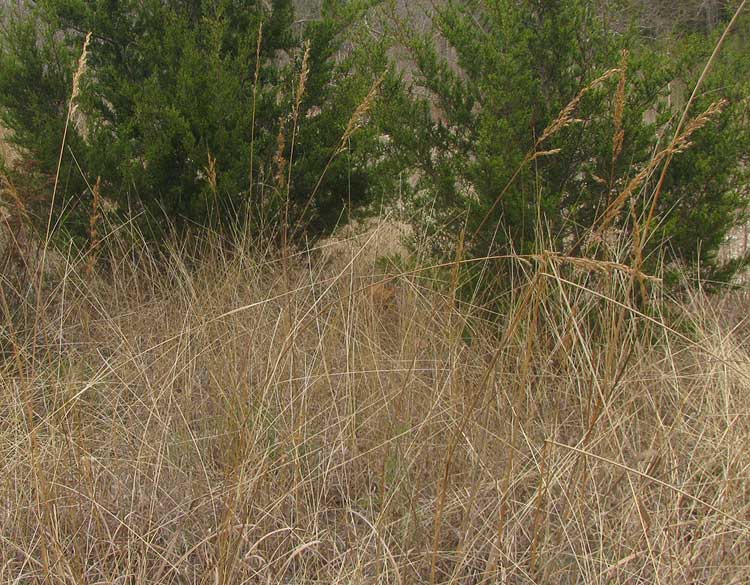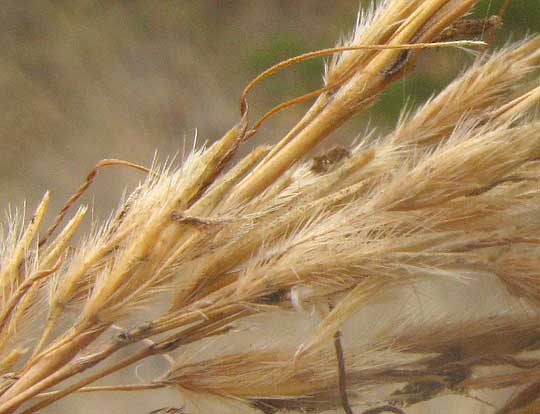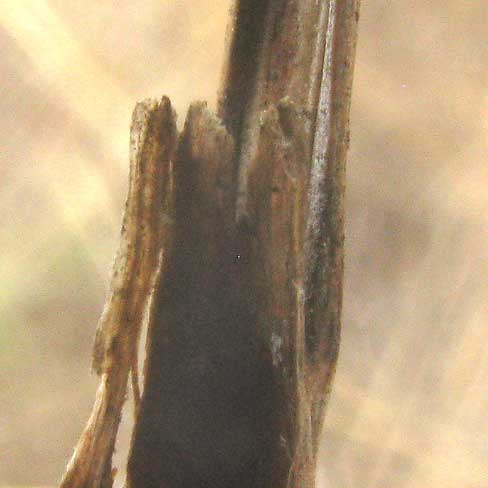Excerpts from Jim Conrad's
Naturalist Newsletter

from the January 5, 2014 Newsletter issued from the Frio Canyon Nature Education Center in the valley of the Dry Frio River in northern Uvalde County, southwestern Texas, on the southern border of the Edwards Plateau; elevation ~1750m (~5750 ft); N29.62°, W99.86°; USA
INDIANGRASS
At this time of year many grass species mingle in pastures and prairie patches colored pale brown-gray and dun. You'd think it would be hard to spot a rare or unusual grass species among so many frost-killed grasses, but actually each species has its own unique manner of presentation, and sometimes subtle differences jump out at you. That happened this week when amidst a lot of bluestem and grama grass a chest-tall grass caught my eye with its slender panicle whose spikelets were heavier looking and more orangish than other grasses'. At the top of this page you can see how their flowering heads overtop their neighbors.
In the East the common Meadow Fescue, abundant along roadsides, produces panicles like that, but I've not seen Meadow Fescue here. A better look at the panicle's shape appears below:

Up closer still, below, it's clear that this was no fescue at all -- not with such long, bent, needle-like "awns" projecting from the spikelets, and all that white-hairiness on the florets:

A look at individual spikelets shaken into my hand is shown below:

Something important to notice in that picture is that beside each spikelet there stands a hairy stem or pedicle. This is a feature of a certain "tribe" of the Grass Family, the Andropogoneae, so noticing this we can eliminate the vast majority of grasses, which don't belong to this tribe. Several well known grasses do, however, such as corn (maize), sugarcane, sorghum, and the bluestems. Within the tribe Andropogoneae most species bear florets atop the hairy pedicle, but this particular species does not, so that's an important field mark for this species.
Also of course when identifying a grass you need to look at the ligule, the wall-like thing -- if it exists at all -- at the blade's base where the blade meets the stem. This species' crumbling, weather-beaten ligule consists of the remains of a stiff, notched membrane, as shown below:

All these features lead us to Indiangrass, SORGHASTRUM NUTANS, which, along with Little Bluestem, Big Bluestem and Switchgrass, was a very important and conspicuous component of America's original tall-grass prairie, sometimes reaching eight feet high (2.4m). Besides in prairies, it turns up in open woods, fields and dry slopes from Quebec to Manitoba south to Florida and Arizona, and into Mexico. It can be found throughout most of Texas but I've not noticed it other than in the canyon's upper reaches, which are more part of the grassy Great Plains Province than our location down the canyon, where we're transitioning into the hot, scrubby Coastal Plain.
Besides Indiangrass's past role of contributing enormous biomass to the prairie ecosystem and thus providing grazing grass for the prairie's large mammals, it also produces edible seeds and nesting material for small mammals and birds. This is one of North America's most important natural grasses.